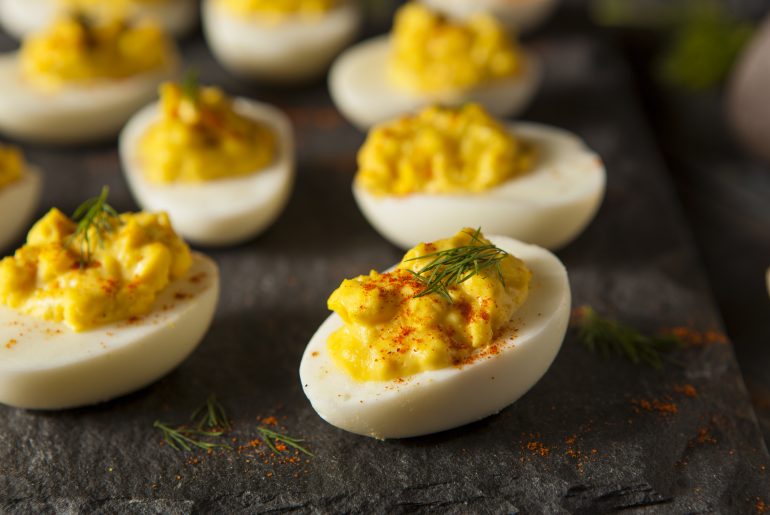Deviled eggs are a staple at brunches, potluck, picnics, and office luncheons — especially around the holidays. The little halved egg appetizer has been a favorite diners look forward to for decades. At this point, many families even have recipes going back several generations. Traditionally made with mayonnaise, mustard, and paprika, deviled eggs are devilishly delicious. So how did something so heavenly get a name so satanic?
It turns out, the history goes back further than you think.
The roots of the modern deviled egg recipe can be traced to ancient Rome, where the wealthy would be served boiled eggs seasoned with spicy sauces before the main meal. Eating eggs pre-meal was so common that the Romans even had a saying, “ab ova usque ad mala” — meaning from “eggs to apples”, or from the beginning to the end of a meal.
Recipes for stuffed eggs began appearing in Andalusia, Spain in the 13th century, then across Europe throughout the 15th century. Stuffed egg recipes hit recipe books in the United States by the mid-19th century.
The first use of the word “devil” as a culinary term appeared in Great Britain in 1786, in reference to ingredients that were hot or highly seasoned, broiled or fried.
The Oxford English Dictionary says, “The term was presumably adopted because of the association between the devil and the excessive heat in Hell.”
By 1800, the term “deviling” became a verb that meant food was cooked with spicy seasoning or over very high heat. While “deviled” was commonly used to describe foods cooked in this way like deviled ham, deviled crab, or deviled short ribs, the term wouldn’t be applied to eggs until much later.
A recipe from Fannie Farmer’s 1896 “Boston Cooking-School Cookbook” was one of the first to use mayonnaise as a binding agent for other ingredients. However, mayo wasn’t available commercially in the United States for another decade.
“Deviled” didn’t meet “eggs” until the post-World War II boom when all the factors finally fell into place. Refrigeration and the availability of commercial mayonnaise met an increase in disposable income for such extras and also the golden era of dinner parties. The modern day deviled egg was hatched.
Today, the original recipe has been adapted, but variations are still widely popular through the United States and Europe. Home cooks and professional chefs alike toy with the classic egg/condiment combo adding wasabi, kimchi, cayenne, buffalo sauce, jalapeños, or just about anything that will kick the flavor up a notch. Crab meat, caviar, capers, anchovy, chives, cheese and other ingredients are incorporated where they are also common in the local cuisine.
In some circles in the U.S. and around the world, the eggs are known as “mimosa eggs,” “stuffed eggs,” “dressed eggs,” or “salad eggs,” — especially when served at church functions — to avoid the association with the devil.
Lower calorie version are sometimes called “angel eggs” as a nod to their lighter ingredient list.
But whatever you call them, or however you make them, it’s a sin not to serve this delicious dish at your next party.
(Reference: History.com)

Deviled Eggs
Ingredients
- 12 large eggs, hardboiled (See here for how to perfectly hard boil an egg)
- 1/3 cup mayonnaise
- 2 tbsp pickle relish
- 1 1/2 tsp dijon mustard
- salt
- pepper
- paprika or Old Bay
Directions
- Gently peel the shell off of the eggs. Cut eggs in half lengthwise.
- Carefully scoop out yolks into a small bowl.
- Add the mayo, relish, and mustard to the yolks and mash with a fork until smooth.
- Add salt and pepper to taste. Add more mayo, mustard or relish, if desired.
- Add a heaping spoonful back into the well of each egg white, or add mixture to a piping bag and pipe in for a fancier end result.
- Sprinkle with paprika right before serving.
Note* Eggs can be stored for up to 3 days in the refrigerator.
Also see, Brie, cranberry and pecan stuffed mushroom appetizer.




